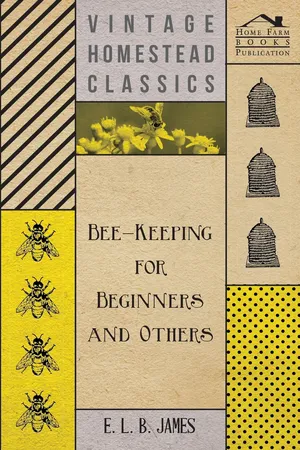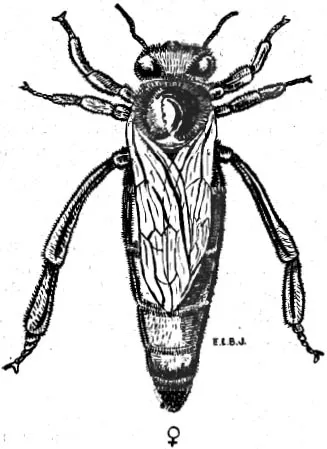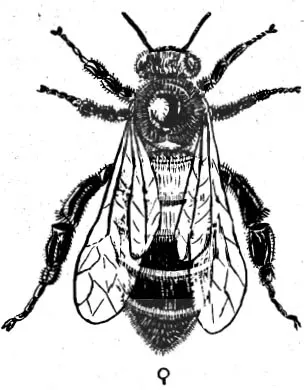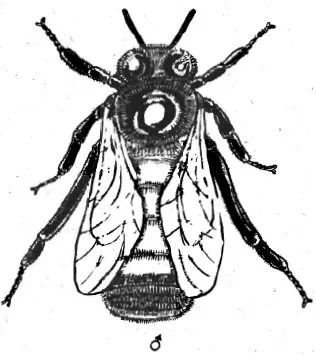
- 304 pages
- English
- ePUB (mobile friendly)
- Available on iOS & Android
eBook - ePub
Bee-Keeping For Beginners And Others
About this book
This antique text contains a detailed guide to bee-keeping, and will appeal to the more advanced beekeeper as well as to the novice. This book is divided into three parts: the first guides the novice from the time when he first decides to take up the craft until the end of his first season; the second deals in detail with the year's work in the apiary, showing how the various problems that confront the bee-keeper in the second and subsequent years should be met; whilst the third, in addition to dealing with diseases and other miscellaneous subjects, contains the formulae and other useful information which more advanced bee-keepers will find of interest. The chapters of this book include: 'The Honey-Bee', 'Natural History', 'The Inhabitants of the Hive', 'The Queen', 'The Workers', 'The Drones', 'Parthenogenesis', 'Metamorphosis', 'Bees and Honey', 'Hives', 'Bee-Keeping in Antiquity', 'The Bee Space', 'British Types', 'The National Hive', 'American Hives', 'Frame Sizes', 'Races of Bees', etcetera. This antique text is being republished here with a new introduction on bee keeping.
Frequently asked questions
Yes, you can cancel anytime from the Subscription tab in your account settings on the Perlego website. Your subscription will stay active until the end of your current billing period. Learn how to cancel your subscription.
At the moment all of our mobile-responsive ePub books are available to download via the app. Most of our PDFs are also available to download and we're working on making the final remaining ones downloadable now. Learn more here.
Perlego offers two plans: Essential and Complete
- Essential is ideal for learners and professionals who enjoy exploring a wide range of subjects. Access the Essential Library with 800,000+ trusted titles and best-sellers across business, personal growth, and the humanities. Includes unlimited reading time and Standard Read Aloud voice.
- Complete: Perfect for advanced learners and researchers needing full, unrestricted access. Unlock 1.4M+ books across hundreds of subjects, including academic and specialized titles. The Complete Plan also includes advanced features like Premium Read Aloud and Research Assistant.
We are an online textbook subscription service, where you can get access to an entire online library for less than the price of a single book per month. With over 1 million books across 1000+ topics, we’ve got you covered! Learn more here.
Look out for the read-aloud symbol on your next book to see if you can listen to it. The read-aloud tool reads text aloud for you, highlighting the text as it is being read. You can pause it, speed it up and slow it down. Learn more here.
Yes! You can use the Perlego app on both iOS or Android devices to read anytime, anywhere — even offline. Perfect for commutes or when you’re on the go.
Please note we cannot support devices running on iOS 13 and Android 7 or earlier. Learn more about using the app.
Please note we cannot support devices running on iOS 13 and Android 7 or earlier. Learn more about using the app.
Yes, you can access Bee-Keeping For Beginners And Others by E. L. B. James in PDF and/or ePUB format, as well as other popular books in Technology & Engineering & Agriculture. We have over one million books available in our catalogue for you to explore.
Information
PART I.
FOR THE BEGINNER
CHAPTER I
THE HONEY-BEE
Natural History. The Inhabitants of the Hive. The Queen. The Workers. The Drones. Parthenogenesis. Metamorphoses. Bees and Honey.
Natural History
IT is surprising how many people are unable to recognise the honey-bee, and imagine that bumble bees seen in their gardens are the producers of the honey that graces their table, also the hard working honey-bee, because of its not dissimilar size, is frequently mistaken by the uninformed for a wasp and, unfortunately, despatched as if it was one of these pests. Therefore, it will not be inappropriate to begin this treatise with a description of the position in the animal kingdom occupied by the honey-bee.
Although there are many different types of bees of the Bombus or “Bumble bee” variety in the British Isles, it is only with the honey-bee, Apis mellifica, that we are concerned. All bees belong to the Arthropoda division of the animal kingdom, which includes such diverse creatures as lobsters, crabs, scorpions, wasps, and insects. This division can be recognised’by the fact that its members have no internal skeleton, their “flesh,” muscles, and internal mechanisms being enclosed in a hard covering or shell of a substance called chitin.
Arthropoda is again divided into a section known as Insecta, and the honey bee falls into a further division called Hymenoptera, i.e., a division of Insecta whose members have two pairs of wings.
The honey-bee has three main parts to its body, the head which carries a pair of antennae or feelers, the eyes, tongue and mouth parts and a pair of mandibles; the thorax carrying the wings, three pairs of legs, and the thoracic spiracles, the external openings of the breathing tubes or lungs, of which we shall hear much more later; and the abdomen which is made up of six tapering telescopic segments, which carry the abdominal spiracles and, in the queen and workers, the sting, and in the former’s case, the generative organs.
The Inhabitants of the Hive
In a colony of honey bees there are present three types of bee, the queen, some 50,000—75,000 workers, and during the summer months, 200—300 drones. The queen is the only perfectly developed female, and her sole function is to produce eggs, of which she may lay from 2,000—3,000 per day, if of a prolific strain, during the height of the season. She is the mother of the entire colony, and is therefore its most important member. The queen, after fertilisation by a drone, can lay two types of eggs, those which will eventuate into workers, and the others into drones. In certain circumstances, when necessary, the workers can rear a queen from an egg that would normally produce a worker bee, by giving the resultant larva special food in distinctive environment. Both the queen and the workers possess a sting, the former only using it against a rival queen, whilst the worker uses hers in defence of the hive.
The workers are sometimes incorrectly described as “neuters”; they are, in fact, undeveloped females, possessing rudimentary ovaries. In certain circumstances, some do lay eggs, but workers, being incapable of impregnation, normally only produce drones, but on certain rare occasions may produce a female parthenogenetically. Worker bees carry out all the duties of the hive, according to their age, acting as house cleaners, nurses to the young brood, water, pollen, and nectar gatherers, wax secreters and comb builders, ventilators of the hive, and the sentries and warriors who protect the home.
The workers are equipped for all the tasks they have to perform, having a honey sac in which to carry nectar or water, a tongue with which to gather liquids, combs for gathering pollen, and corbiculae or baskets on the rear pair of legs in which to carry it after it has been compressed into pellets. Wax pockets are situated between the ventral segments of the abdomen, and tools are carried on the legs with which to handle the wax scales prior to moulding them with the mandibles into the hexagonal cells which make up the honey combs that serve as nurseries for the brood, and storage space for nectar and pollen.
The drones are the male bees, and are produced in spring and summer, for the sole purpose of ensuring that any virgin queens that may be raised will be fertilised. They are incapable of doing any work, and at the end of the summer, when no longer needed, are turned out of the hive to die.
Parthenogenesis
The bee goes through the usual three stages common to insects prior to attaining the fourth stage, that of imago or perfect insect, the three stages being those of egg, larva or grub and pupa or nymph.
It has been shown that the queen can lay two types of egg, one which will produce a worker, and another that will eventuate into a drone. This is due to the fact that when a queen mates, the semen from the male does not fertilise the eggs in her ovaries, but enters a little sac at the base of her abdomen, situated just below the point where the ducts from the two ovaries join to form the passage to the vagina. Thereafter, if the queen lays an egg that is to produce a drone, the egg passes out through the oviduct without coming in contact with the spermatheca, whereas, if the egg is to produce a worker, a valve is opened on the spermatheca, and as the egg passes, so it receives some spermatozoa that have been stored in the spermatheca ever since the queen mated.
PLATE I ITALIAN BEES

FIG. 1
THE QUEEN
THE QUEEN

FIG. 2
THE WORKER
THE WORKER

FIG. 3
THE DRONE
THE DRONE
Thus, the worker is the product of an egg that has been fertilised by some of the male element which enters the egg through the micropyle at its top end, and the drone is the product of an egg which contains none of the male element. The drone is therefore produced parthenogenetically, and is fatherless, though he himself may become the father of countless thousands of workers.
When once a queen has been fertilised, she remains fertile for the rest of her useful life, which may be three years. Queens have been known to live for five years, but usually after the second year her fertility decreases, due to the supply of spermatozoa in her spermatheca becoming exhausted.
It was thought until recently that a queen mated but once in her lifetime, but recent observations tend to disprove this theory, and she may, in fact, leave the hive more than once on a wedding flight. Whilst the drone has no father, he has a maternal grandfather, and he therefore stands in relationship to workers and queens bred from the same mother as an “uncle” and not as a brother. It is important to remember this when breeding bees.
It will be seen that the relationship between the males and females of the honey-bee reduces the risk of too close inbreeding. This may well be nature’s way of maintaining stamina which might be adversely affected if brother mated to sister over many generations. Due to the Parthenogenetic birth of the drone, amongst bees there is no such relationship.
Metamorphosis
The times taken from the laying of the egg, to the emergence of the imago, are as follows, shown in days:

Sometimes the queen may emerge on the fifteenth or as late as the seventeenth day, depending upon conditions of temperature.
Bees and Honey
We are all very apt to regard bees as being with us only to produce that delicious and health-giving sweet, honey, for our enjoyment. This is not the case, in Nature’s scheme of things the honey-bee’s prime function is to ensure the perpetuation of fruits, certain crops and flowers : that she produces surplus honey in the process for the bee-keeper, is purely coincidental.
In order that fruits, etc., can reproduce their kind, it is necessary that the male fertilising pollen dust be transferred to the female element of the flower or blossom so that seeds may be formed. In the case of some species, the pollen is borne by the wind, but fruits, the leguminae and other important crops rely on the pollination being carried out by insects, the principal agent being the honey-bee. In order to attract the bee to fulfil this function, the flowers produce a sweet, watery substance known as nectar. This, when processed by the bee, becomes honey which is its staple diet, and in visiting the flowers for its collection, the hairs which cover the bee’s body collect the pollen from the male organs of the blossom and, as she brushes against the female, element in other blossoms whilst in search of nectar, so the fertilising dust is transferred, and the bee fulfils its main function. After being collected by the foragers this raw nectar is stored in the honey combs where it is ripened and eventually sealed over with a wax capping. Nectar or, when it is ripened, honey, forms with pollen and water the three items of food required by bees to keep themselves throughout the year and to feed the young larvae during the months when brood is being raised.
The season when nectar is available for collection varies in different parts of the country, according to whether spring is early or late and the types of flowers and blossoms that are grown locally. Roughly, however, it may be said that the first nectar available in any quantity is from the fruit blossoms in late April and that, with the exception of heather districts, the nectar flow ends in late July. It will be seen, therefore, that in addition to collecting nectar for their daily needs from April to July, sufficient must be stored to last through the autumn and winter months until such a time as nectar shall again be available in the following spring.
In a normal season during the months of May—July, the amount of nectar gathered usually exceeds the daily consumption, consequently this accumulation is stored for use at some later date. Due to the great energy and acquisitive instinct of the bee, a colony does not cease storing as soon as sufficient honey has been stored to last from autumn until spring, it goes on gathering and storing just so long as there is any nectar available.
It is this strong acquisitive instinct that enables man to enjoy the delights of honey without any detriment to the bees, as under modern systems of management and with modern equipment, bees are able to store large amounts of honey in excess of their annual requirements. It is this amount, over and above the needs of the bees themselves, which is known as “surplus,” and is removed by the bee-keeper from the hive for his own use, the amount of surplus depending upon the locality, the weather, the strain of bee and, last but not least, the skill of the bee-keeper.
By and large, the average surplus per colony throughout the country may be taken at 50 lbs., though in some seasons in favourable districts, over 100 lbs. per colony is not unusual. This surplus is reckoned after allowance is made, in the autumn, for the amount necessary to last the colony through the autumn and winter until the following spring, i.e., 40 lbs. of honey at least.
It is only by understanding the natural laws which govern the life of the bee colony that the bee-keeper is able to secure a bigger surplus, upon the obtaining of which depends the size of his profits. Bees cannot be driven in a direction which is opposed to that in which the laws that rule their existence compel them to go, but with a knowledge of these laws the bee-keeper is able to guide his bees along the paths which he wishes them to follow to the advantage of both—surplus honey for the bee-keeper, security, health and prosperity for the bees.
In order to see how this desirable achievement can be attained, it is necessary to examine the life of a bee colony when living in its natural state, operating under natural laws, without the interference of man.
CHAPTER II
A YEAR IN THE LIFE OF A BEE COLONY
Autumn. Winter. Spring. Summer. Swarming. The Swarm. The New Home. The Old Colony. Casts. Rehabilitation. Swarming and Honey Production
IN their natural state, honey-bees may be found living in such places as hollow trees, church towers, the space between the outer and inner walls of a house or shed; anywhere in fact where shelter from wind and rain can be obtained. That man has, from times of antiquity, induced them to live in beehives, does not mean that bees have been “domesticated” in the sense that man has domesticated cattle, dogs and other homely animals. The bee’s instincts, behaviour and modus vivendi are the same whether they are “wild” or “domesticated” but by keeping bees in modern hives their activities can be controlled. This enables the bee-keeper to anticipate his bees’ requirements and thus to keep them in the condition whereby the surplus produced will be far greater in relation to the amount of honey required for their own consumption than would be the case if they were left to their own devices.
Let us consider a colony for example, living in a hollow tree trunk, and see how it would fare in its natural habitat if not interfered with by man during the period of a twelvemonth.
Autumn
This colony in August after the main nectar flow is over, would probably consist of some 50,000 worker bees, the queen, and perhaps a couple of hundred drones. They might be occupying eight or ten waxen combs hanging some twelve to twenty inches in length, down the hollow of the tree trunk, spaced approximately 1 1/2 ins. from centre to centre being attached along their tops and sides to the inside of the tree trunk.
The combs contain two types of cells, each of which is hexagonal, built out from both sides of a midrib, each cell having a slight upward tilt from the horizontal. The two types of cells consist of those in which worker brood is reared and in which pollen and honey is stored, measuring five to the inch; the other type, of which there are only about four or five hundred in a colony, are larger, and measure approximately four to the inch. These are used for rearing drone bees, but sometimes may also be used for storage if the colony is pressed for space.
The main nectar flow being over, and winter approaching, the bees now begin the autumnal slaughter of the drones. They are herded together away from the open honey cells, and food is withheld from them by the workers, so that in their weakened state they are easily dragged forth and cast incontinently from the entrance. Being prevented from re-entering, they s...
Table of contents
- Cover
- Title
- Copyright
- Bee Keeping
- Dedication
- Contents
- Illustrations
- Acknowledgements
- Preface
- Foreword
- Part I. For the Beginner
- Part II. General Management
- Part III